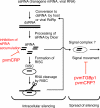A dual strategy for the suppression of host antiviral silencing: two distinct suppressors for viral replication and viral movement encoded by potato virus M
- PMID: 21752911
- PMCID: PMC3196401
- DOI: 10.1128/JVI.05273-11
A dual strategy for the suppression of host antiviral silencing: two distinct suppressors for viral replication and viral movement encoded by potato virus M
Abstract
Viruses encode RNA silencing suppressors to counteract host antiviral silencing. In this study, we analyzed the suppressors encoded by potato virus M (PVM), a member of the genus Carlavirus. In the conventional green fluorescent protein transient coexpression assay, the cysteine-rich protein (CRP) of PVM inhibited both local and systemic silencing, whereas the triple gene block protein 1 (TGBp1) showed suppressor activity only on systemic silencing. Furthermore, to elucidate the roles of these two suppressors during an active viral infection, we performed PVX vector-based assays and viral movement complementation assays. CRP increased the accumulation of viral RNA at the single-cell level and also enhanced viral cell-to-cell movement by inhibiting RNA silencing. However, TGBp1 facilitated viral movement but did not affect viral accumulation in protoplasts. These data suggest that CRP inhibits RNA silencing primarily at the viral replication step, whereas TGBp1 is a suppressor that acts at the viral movement step. Thus, our findings demonstrate a sophisticated viral infection strategy that suppresses host antiviral silencing at two different steps via two mechanistically distinct suppressors. This study is also the first report of the RNA silencing suppressor in the genus Carlavirus.
Figures







Similar articles
-
[Interaction of cysteine-rich protein of Carlavirus with plant defense system].Mol Biol (Mosk). 2005 Sep-Oct;39(5):896-904. Mol Biol (Mosk). 2005. PMID: 16240723 Russian.
-
N-terminal region of cysteine-rich protein (CRP) in carlaviruses is involved in the determination of symptom types.Mol Plant Pathol. 2018 Jan;19(1):180-190. doi: 10.1111/mpp.12513. Epub 2017 Jan 25. Mol Plant Pathol. 2018. PMID: 27868376 Free PMC article.
-
Variability in the level of RNA silencing suppression caused by triple gene block protein 1 (TGBp1) from various potexviruses during infection.J Gen Virol. 2009 Apr;90(Pt 4):1014-1024. doi: 10.1099/vir.0.008243-0. Epub 2009 Mar 4. J Gen Virol. 2009. PMID: 19264652
-
The dual edge of RNA silencing suppressors in the virus-host interactions.Curr Opin Virol. 2016 Apr;17:39-44. doi: 10.1016/j.coviro.2015.12.002. Epub 2016 Jan 21. Curr Opin Virol. 2016. PMID: 26802204 Review.
-
viral silencing suppressors: Tools forged to fine-tune host-pathogen coexistence.Virology. 2015 May;479-480:85-103. doi: 10.1016/j.virol.2015.02.028. Epub 2015 Mar 9. Virology. 2015. PMID: 25766638 Review.
Cited by
-
The alteration of plant morphology by small peptides released from the proteolytic processing of the bacterial peptide TENGU.Plant Physiol. 2013 Aug;162(4):2005-14. doi: 10.1104/pp.113.218586. Epub 2013 Jun 19. Plant Physiol. 2013. PMID: 23784461 Free PMC article.
-
Current Developments and Challenges in Plant Viral Diagnostics: A Systematic Review.Viruses. 2021 Mar 5;13(3):412. doi: 10.3390/v13030412. Viruses. 2021. PMID: 33807625 Free PMC article.
-
Shallot virus X p42 Protein Expressed in Concert with Virus Movement Proteins Is a Suppressor of Two Plant Antiviral Defense Mechanisms.Plants (Basel). 2025 Aug 16;14(16):2552. doi: 10.3390/plants14162552. Plants (Basel). 2025. PMID: 40872175 Free PMC article.
-
Identification of the amino acid residues and domains in the cysteine-rich protein of Chinese wheat mosaic virus that are important for RNA silencing suppression and subcellular localization.Mol Plant Pathol. 2013 Apr;14(3):265-78. doi: 10.1111/mpp.12002. Mol Plant Pathol. 2013. PMID: 23458485 Free PMC article.
-
Overview on Sobemoviruses and a Proposal for the Creation of the Family Sobemoviridae.Viruses. 2015 Jun 15;7(6):3076-115. doi: 10.3390/v7062761. Viruses. 2015. PMID: 26083319 Free PMC article. Review.
References
-
- Baulcombe D. 2004. RNA silencing in plants. Nature 431:356–363 - PubMed
-
- Baumberger N., Tsai C. H., Lie M., Havecker E., Baulcombe D. C. 2007. The polerovirus silencing suppressor P0 targets Argonaute proteins for degradation. Curr. Biol. 17:1609–1614 - PubMed
-
- Bayne E. H., Rakitina D. V., Morozov S. Y., Baulcombe D. C. 2005. Cell-to-cell movement of potato potexvirus X is dependent on suppression of RNA silencing. Plant J. 44:471–482 - PubMed
Publication types
MeSH terms
Substances
LinkOut - more resources
Full Text Sources
Research Materials
Miscellaneous

